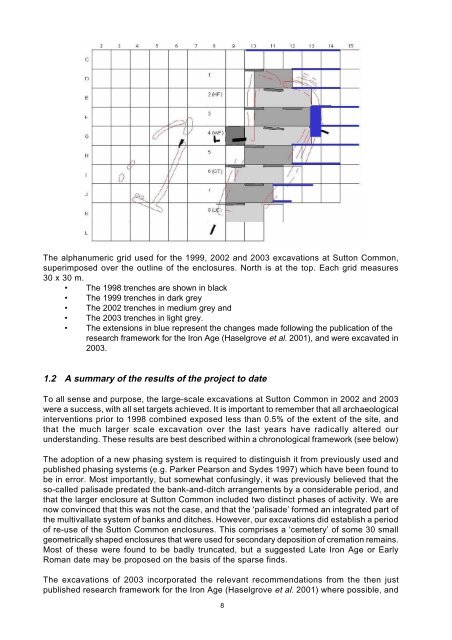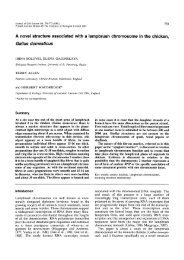Sutton Common Updated project design - University of Exeter
Sutton Common Updated project design - University of Exeter
Sutton Common Updated project design - University of Exeter
Create successful ePaper yourself
Turn your PDF publications into a flip-book with our unique Google optimized e-Paper software.
The alphanumeric grid used for the 1999, 2002 and 2003 excavations at <strong>Sutton</strong> <strong>Common</strong>,<br />
superimposed over the outline <strong>of</strong> the enclosures. North is at the top. Each grid measures<br />
30 x 30 m.<br />
• The 1998 trenches are shown in black<br />
• The 1999 trenches in dark grey<br />
• The 2002 trenches in medium grey and<br />
• The 2003 trenches in light grey.<br />
• The extensions in blue represent the changes made following the publication <strong>of</strong> the<br />
research framework for the Iron Age (Haselgrove et al. 2001), and were excavated in<br />
2003.<br />
1.2 A summary <strong>of</strong> the results <strong>of</strong> the <strong>project</strong> to date<br />
To all sense and purpose, the large-scale excavations at <strong>Sutton</strong> <strong>Common</strong> in 2002 and 2003<br />
were a success, with all set targets achieved. It is important to remember that all archaeological<br />
interventions prior to 1998 combined exposed less than 0.5% <strong>of</strong> the extent <strong>of</strong> the site, and<br />
that the much larger scale excavation over the last years have radically altered our<br />
understanding. These results are best described within a chronological framework (see below)<br />
The adoption <strong>of</strong> a new phasing system is required to distinguish it from previously used and<br />
published phasing systems (e.g. Parker Pearson and Sydes 1997) which have been found to<br />
be in error. Most importantly, but somewhat confusingly, it was previously believed that the<br />
so-called palisade predated the bank-and-ditch arrangements by a considerable period, and<br />
that the larger enclosure at <strong>Sutton</strong> <strong>Common</strong> included two distinct phases <strong>of</strong> activity. We are<br />
now convinced that this was not the case, and that the ‘palisade’ formed an integrated part <strong>of</strong><br />
the multivallate system <strong>of</strong> banks and ditches. However, our excavations did establish a period<br />
<strong>of</strong> re-use <strong>of</strong> the <strong>Sutton</strong> <strong>Common</strong> enclosures. This comprises a ‘cemetery’ <strong>of</strong> some 30 small<br />
geometrically shaped enclosures that were used for secondary deposition <strong>of</strong> cremation remains.<br />
Most <strong>of</strong> these were found to be badly truncated, but a suggested Late Iron Age or Early<br />
Roman date may be proposed on the basis <strong>of</strong> the sparse finds.<br />
The excavations <strong>of</strong> 2003 incorporated the relevant recommendations from the then just<br />
published research framework for the Iron Age (Haselgrove et al. 2001) where possible, and<br />
8
















